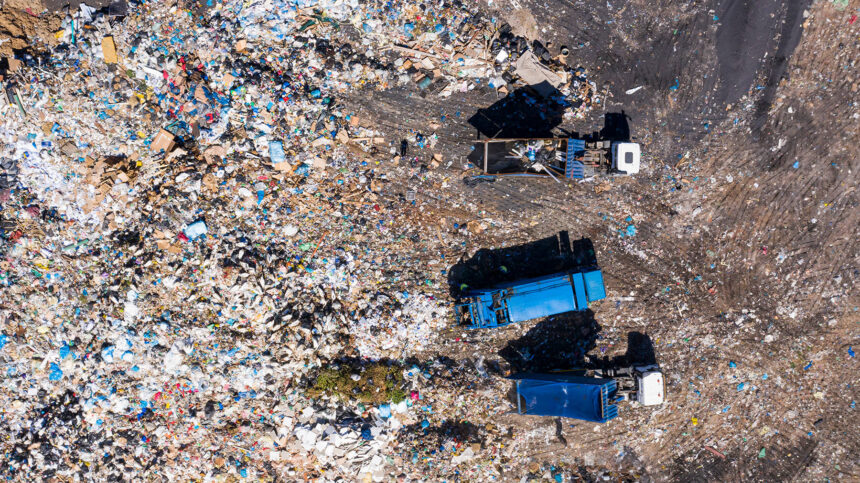In the environmental management of landfills around the world, accurate monitoring of methane emissions has always been the core of environmental protection work. However, in landfills with complex terrain and harsh environments, such as valleys, wetlands or remote mountainous areas, traditional monitoring methods are often difficult to cover, resulting in potential methane leaks that cannot be discovered and controlled in a timely manner. In recent years, with the combination of drones and high-precision methane detector, this problem has been effectively solved, providing strong technical support for the green operation and safety supervision of landfills.
Difficulties In Methane Monitoring At Landfills In Extreme Terrain
Due to terrain restrictions, data collection is difficult
In valleys or hilly areas, landfills are usually distributed in irregular terrain, and traditional ground monitoring equipment is difficult to enter all areas, resulting in some methane leaks that cannot be detected. In addition, the diffusion of landfill gas is affected by complex terrain, which may lead to abnormally high methane concentrations in local areas, but due to insufficient detection coverage, it is difficult to issue timely warnings.
Special challenges of wetland landfills
Due to the high groundwater level in wetland landfills, methane can easily spread through water bodies and affect the surrounding ecological environment. Compared with general landfills, methane emissions from wetland landfills are more hidden, and it is often difficult to capture their diffusion paths by relying solely on ground sensors.
Safety issues in high-risk areas
Many landfills in remote areas have poor infrastructure and there are great risks for personnel to enter for monitoring. For example, steep slopes, soft surfaces, or unstable strata in abandoned landfills may pose a threat to the safety of on-site workers.
Synergistic Advantages Of Drones And Methane Detectors
In the face of these challenges, the breakthrough point of modern methane monitoring technology lies in the combination of drones and high-precision detectors. Drones equipped with methane detectors can operate flexibly in complex terrain environments and achieve large-scale and efficient methane concentration monitoring.
Aerial inspection covers the entire site
Using drones equipped with methane detectors can bypass the obstacles of traditional ground monitoring and conduct a full-scale scan of the landfill. Drones can fly along the terrain contours of the landfill and accurately measure the methane concentration in different areas, especially in inaccessible areas such as steep slopes or wetland centers.
Real-time data transmission and analysis
Modern methane detectors have high sensitivity and real-time data transmission functions. They can directly transmit methane concentration data during flight and visualize it through cloud analysis systems. This allows environmental regulators to remotely grasp the emissions of landfills and quickly identify potential leaks.
Improve monitoring efficiency and safety
Drones can complete large-scale inspection tasks in a short period of time, reducing the time cost of manual inspections and avoiding exposure of personnel in high-risk areas. For example, in mountain landfills, drones can replace traditional personnel climbing and measurement methods to improve work safety.
US Case: Methane Monitoring at Remote Landfills in Colorado
An abandoned landfill in Colorado is located in a mountainous area. Due to the rugged terrain, traditional monitoring methods are difficult to fully cover. There have been surface explosions caused by methane accumulation in the area, so the local government decided to introduce drone methane monitoring technology.
During the implementation of the project, drones were equipped with high-precision methane detectors to systematically cruise the landfill and draw methane concentration distribution maps in real time. The results showed that the methane concentration in some low-lying areas of the landfill was abnormally high, and the gas diffusion path was affected by the wind direction in the valley, which posed a potential risk. Through data analysis, the management added a methane collection system at key points to reduce environmental and safety risks.
Future Development Direction Of Extreme Terrain Methane Monitoring
With the continuous advancement of technology, methane monitoring in extreme terrain landfills will be more intelligent and automated in the future.
Multi-sensor fusion monitoring
In the future, drones will not only be equipped with methane detectors, but will also combine thermal imaging, lidar and other technologies to achieve multi-dimensional analysis of landfill gas diffusion. This will help to more accurately identify methane escape points and improve detection accuracy.
AI and big data analysis
Through artificial intelligence (AI) and big data analysis, the methane emission trend of landfills can be tracked for a long time and an intelligent prediction model can be formed. This will help managers to warn high-risk areas in advance and formulate more effective emission reduction measures.
Automated drone inspection system
In the future, some landfills may deploy fully automatic drone inspection systems, which can autonomously take off, cruise, detect and send back data within a preset time to achieve 24-hour uninterrupted monitoring.
Conclusion
Accurate monitoring of methane emissions from landfills is essential for environmental protection and safe operation, especially in extreme terrain conditions, where traditional monitoring methods are often inadequate. The combination of drones and high-precision methane detectors provides an efficient and safe monitoring solution for these complex environments.
In the future, with the continuous iteration of technology and increasingly stringent environmental supervision, methane monitoring methods will become more intelligent, providing stronger support for the sustainable development of landfills. In this process, high-precision detection equipment and automated monitoring technology will become an important tool to promote the improvement of global landfill management levels.




